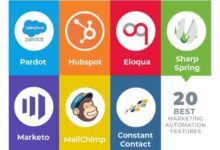Big Data for Human Resource Management: Revolutionizing the Way Businesses Thrive
In the era of digital transformation, businesses are constantly seeking new ways to optimize their operations and gain a competitive edge. One such method that has revolutionized the field of human resource management is the utilization of big data. By harnessing the power of massive datasets, companies can now make data-driven decisions to attract, retain, and develop top talent. In this comprehensive blog article, we will delve into the intricacies of big data for human resource management, exploring its applications, benefits, and potential challenges.
Firstly, we will explore the concept of big data and its relevance in the HR landscape. Understanding what constitutes big data and how it is collected will set the foundation for our discussion. We will then delve into the various applications of big data in human resource management, ranging from talent acquisition and performance management to employee engagement and workforce planning. Each section will provide a detailed summary of how big data can be leveraged to optimize HR processes and drive organizational success.
The Power of Big Data in Talent Acquisition
With the ever-increasing competition for top talent, organizations are turning to big data to streamline their recruitment processes. Big data analytics can help identify the right candidates, enhance candidate experience, and improve the overall efficiency of the hiring process.
Identifying the Right Candidates
Traditional recruitment methods often rely on resumes and interviews, which can be subjective and prone to bias. However, big data analytics can analyze vast amounts of data from various sources, such as social media profiles, online job boards, and professional networks, to identify candidates with the right skills, experience, and cultural fit. By leveraging machine learning algorithms, HR professionals can save time and resources by focusing on the most promising candidates.
Enhancing Candidate Experience
Candidate experience plays a crucial role in attracting and retaining top talent. Big data can help organizations personalize the recruitment process by analyzing candidate preferences and behavior. By understanding the preferences of candidates, such as preferred communication channels and interview formats, companies can tailor their recruitment strategies to provide a seamless and engaging experience for applicants.
Improving Hiring Process Efficiency
The hiring process can be time-consuming and resource-intensive, especially when organizations receive a high volume of applications. Big data analytics can automate and streamline various stages of the hiring process, such as resume screening and candidate shortlisting. By utilizing algorithms that match candidate profiles with job requirements, HR professionals can expedite the selection process and focus on the most qualified candidates.
Unleashing the Potential of Big Data in Performance Management
Traditional performance management systems often fall short in providing meaningful insights and driving employee productivity. Big data can transform performance management by enabling real-time feedback, identifying performance patterns, and facilitating personalized development plans.
Real-Time Feedback and Performance Monitoring
Traditional performance reviews typically occur on an annual or semi-annual basis, which limits the ability to provide timely feedback and address performance issues promptly. With big data analytics, organizations can collect and analyze real-time performance data, such as project outcomes, customer feedback, and peer evaluations. This enables managers to provide continuous feedback and coaching, leading to improved performance and employee growth.
Identifying Performance Patterns and Trends
Big data analytics can uncover patterns and trends in performance data that may not be immediately apparent. By analyzing large datasets, organizations can identify factors that contribute to high performance and those that hinder productivity. This insight allows HR professionals to develop targeted interventions and strategies to enhance performance and address any underlying issues.
Personalized Development Plans
One-size-fits-all development plans may not effectively cater to the unique needs and aspirations of individual employees. Big data analytics can help HR professionals identify specific areas for development and create personalized development plans. By analyzing employee data, such as skills assessments, training history, and career goals, organizations can provide tailored learning opportunities that align with employee ambitions, resulting in increased engagement and retention.
Enhancing Employee Engagement through Big Data
Employee engagement is crucial for organizational success, yet it can be challenging to gauge and improve. Big data analytics can uncover hidden patterns and factors influencing employee engagement, enabling HR professionals to implement targeted initiatives that drive motivation, satisfaction, and loyalty.
Identifying Engagement Drivers
Big data analytics can analyze various data sources, such as employee surveys, performance data, and social media sentiment, to identify factors that contribute to employee engagement. By understanding the key drivers, organizations can focus on initiatives that address specific areas, such as leadership, communication, and work-life balance, to foster a more engaged workforce.
Predicting Disengagement and Turnover
High employee turnover can be costly for organizations. Big data analytics can identify patterns and signals that indicate disengagement and potential turnover. By analyzing data such as absenteeism rates, performance trends, and employee feedback, HR professionals can proactively intervene and implement retention strategies to retain top talent.
Optimizing Employee Recognition and Rewards
Recognizing and rewarding employees for their contributions is essential for fostering engagement and motivation. Big data analytics can provide insights into the most effective recognition and rewards programs by analyzing data on employee preferences, satisfaction levels, and performance outcomes. This enables HR professionals to design targeted recognition initiatives that resonate with employees and drive a positive organizational culture.
Leveraging Big Data for Workforce Planning and Succession Management
Effective workforce planning and succession management are critical for long-term organizational sustainability. Big data provides valuable insights into workforce demographics, skills gaps, and future talent needs, empowering HR professionals to proactively address potential challenges.
Analyzing Workforce Demographics and Trends
Big data analytics can analyze workforce demographics, such as age, gender, and diversity, to identify potential gaps and imbalances. By understanding the current composition of the workforce and predicting future trends, organizations can develop strategies to ensure a diverse and inclusive workforce that aligns with business goals.
Identifying Skills Gaps and Training Needs
Skills gaps can hinder organizational growth and competitiveness. Big data analytics can analyze employee skills data, performance data, and industry trends to identify current and future skills gaps. By understanding the specific skills needed for future success, HR professionals can develop targeted training programs and recruitment strategies to bridge these gaps and ensure a skilled and adaptable workforce.
Succession Planning and Talent Development
Succession planning is crucial for ensuring continuity in leadership and critical roles. Big data analytics can identify high-potential employees based on performance, skills, and career aspirations. By analyzing data on employee performance, career progression, and potential, HR professionals can create robust succession plans and targeted talent development programs to nurture and retain top talent.
Overcoming Challenges in Implementing Big Data for HR
While the potential benefits of big data for HR are immense, there are notable challenges to overcome. Understanding and addressing these challenges is crucial to ensure successful implementation and adoption of big data strategies.
Data Quality and Integration
One of the key challenges in utilizing big data for HR is ensuring data quality and integration. HR departments often have various systems and databases that store employee data, such as HRIS, performance management systems, and learning management systems. Integrating and standardizing these data sources is essential to ensure accurate and consistent analysis.
Data Privacy and Security
Utilizing big data for HR purposes requires careful attention to data privacy and security. HR professionals must comply with relevant data protection regulations and ensure that employee data is handled responsibly. Implementing robust security measures, obtaining appropriate consents, and anonymizing data when necessary are essential to protect employee privacy.
Change Management and Employee Acceptance
Introducing big data analytics in HR may require a cultural shift within the organization. Employees may be apprehensive about the use of data in decision-making processes. HR professionals must effectively communicate the benefits and address any concerns to ensure employee acceptance and engagement with the new approach.
The Ethical Considerations of Big Data in HR
As big data becomes more prevalent in HR, ethical concerns surrounding data privacy and security arise. Organizations must address these ethical considerations when utilizing big data for HR purposes to ensure transparency, consent, and responsible data usage.
Transparency and Informed Consent
Organizations must be transparent about the data they collect, how it will be used, and obtain informed consent from employees. Employees should have a clear understanding of the purpose of data collection and how it will impact their employment. Transparent communication builds trust and ensures employees feel comfortable with the use of their data.
Responsible Data Usage and Avoiding Bias
HR professionals must ensure responsible data usage by avoiding biased decision-making based on sensitive attributes such as race, gender, or age. Using machine learning algorithms and data anonymization techniques can help reduce the risk of biased outcomes and ensure fairness in HR practices.
Data Security and Protection
Protecting employee data from unauthorized access and breaches is of paramount importance. Organizations must implement robust security measures, such as encryption, access controls, and regular audits, to safeguard employee data. Regular training and awareness programs can also help employees understand their role in maintaining data security.
Case Studies: Real-World Applications of Big Data in HR
Examining real-world examples is crucial to understandingthe tangible impact of big data in HR. In this section, we will showcase case studies of organizations that have successfully implemented big data strategies to enhance various HR functions, providing inspiration and practical insights for readers.
Case Study 1: Company X – Optimizing Talent Acquisition
Company X, a global technology company, leveraged big data analytics to revolutionize their talent acquisition process. By analyzing vast amounts of data from job boards, social media platforms, and internal databases, they were able to identify the most effective channels to attract top talent. Additionally, they utilized predictive analytics to identify high-potential candidates based on their online presence and past performance. This data-driven approach resulted in a more efficient and targeted recruitment process, leading to higher-quality hires and reduced time-to-fill metrics.
Case Study 2: Company Y – Enhancing Performance Management
Company Y, a multinational retail organization, implemented big data analytics to improve their performance management system. By integrating data from various sources, such as sales figures, customer feedback, and employee assessments, they gained a holistic view of individual and team performance. This enabled managers to provide real-time feedback and coaching, addressing performance issues promptly. Furthermore, the organization utilized sentiment analysis to gauge employee satisfaction and engagement, allowing them to proactively identify areas for improvement and implement tailored development plans. As a result, Company Y experienced increased employee productivity and satisfaction.
Case Study 3: Company Z – Driving Employee Engagement
Company Z, a leading financial services firm, used big data analytics to enhance employee engagement. By analyzing employee feedback surveys, social media sentiment, and performance data, they identified key drivers of engagement within their organization. Leveraging this insight, they implemented targeted initiatives, such as leadership development programs, flexible work arrangements, and recognition programs. Through continuous monitoring and analysis of employee engagement data, Company Z was able to make data-driven adjustments to their initiatives, resulting in a significant increase in employee satisfaction and retention rates.
The Future of Big Data in HR: Emerging Trends and Innovations
The field of big data is constantly evolving, and HR is no exception. In this section, we will explore emerging trends and innovations in big data for HR, such as predictive analytics, sentiment analysis, and artificial intelligence, offering a glimpse into the exciting possibilities that lie ahead.
Predictive Analytics for HR Decision-Making
Predictive analytics is gaining traction in HR, allowing organizations to forecast future trends and outcomes based on historical data. By leveraging predictive models, HR professionals can make data-driven decisions in areas such as talent acquisition, succession planning, and workforce optimization. These predictive insights enable organizations to proactively address challenges and seize opportunities.
Sentiment Analysis for Employee Feedback
Sentiment analysis, a technique that uses natural language processing to analyze emotions and opinions expressed in text data, can provide valuable insights into employee feedback. By applying sentiment analysis to employee surveys, social media posts, and internal communication channels, organizations can gain a deeper understanding of employee sentiment, identify areas of concern, and make targeted improvements to enhance engagement and satisfaction levels.
Artificial Intelligence for HR Automation
Artificial intelligence (AI) has the potential to automate various HR processes, saving time and resources. AI-powered chatbots can handle routine HR inquiries, freeing up HR professionals to focus on strategic initiatives. Machine learning algorithms can analyze vast amounts of data to identify patterns and make predictions, enabling HR professionals to make data-driven decisions. The integration of AI in HR systems can streamline processes and enhance the employee experience.
Tools and Technologies for Big Data in HR
Implementing big data strategies requires the right tools and technologies. In this section, we will provide an overview of the various software, platforms, and analytics tools available to HR professionals, enabling them to effectively collect, process, and analyze data for impactful decision-making.
HR Analytics Platforms
Several HR analytics platforms, such as Tableau, Power BI, and IBM Watson Analytics, provide user-friendly interfaces and powerful analytics capabilities. These platforms allow HR professionals to integrate data from various sources, perform advanced analytics, and generate visualizations to gain insights and make informed decisions.
Machine Learning and AI Tools
Tools like Python, R, and TensorFlow enable HR professionals to leverage machine learning algorithms for predictive modeling and data analysis. These tools provide a wide range of algorithms and techniques that can be applied to various HR scenarios, such as talent prediction, attrition analysis, and sentiment analysis.
Data Visualization Tools
Data visualization tools, such as Tableau, D3.js, and Microsoft Power BI, help HR professionals present complex data in a visually appealing and understandable way. These tools enable the creation of interactive dashboards and reports that facilitate data exploration and communication of insights to stakeholders.
Building a Data-Driven HR Culture: Best Practices and Key Takeaways
Adopting a data-driven mindset is crucial for organizations to fully harness the potential of big data in HR. In this final section, we will outline best practices and key takeaways for building a data-driven HR culture, empowering organizations to leverage big data as a strategic asset and drive sustainable growth.
Define Clear Objectives and Key Metrics
It is essential to clearly define the objectives and key metrics that align with the organization’s strategic goals. By identifying the specific HR outcomes you want to achieve and the metrics that measure success, you can focus your data collection and analysis efforts on what truly matters.
Invest in Data Literacy and Analytics Skills
Building a data-driven HR culture requires investing in data literacy and analytics skills within the HR department. HR professionals should acquire the necessary skills to collect, analyze, and interpret data effectively. Training programs and workshops can help develop these skills and create a data-driven mindset across the HR team.
Promote Collaboration and Knowledge Sharing
To maximize the benefits of big data in HR, encourage collaboration and knowledge sharing among HR professionals. Establish cross-functional teams that include data analysts, HR specialists, and business leaders to foster a holistic approach to data analysis and decision-making. Sharing insights and best practices across the organization promotes continuous learning and improvement.
In conclusion, big data has become a game-changer in the field of human resource management, enabling organizations to make data-driven decisions that optimize their talent strategies and drive organizational success. By harnessing the power of big data analytics, HR professionals can revolutionize talent acquisition, performance management, employee engagement, and workforce planning. However, it is important to address ethical considerations and overcome implementation challenges to ensure responsible and effective use of big data in HR. With the right tools, technologies, and a data-driven mindset, organizations can unlock the full potential of big data and pave the way for a brighter future of HR.


